Sir Richard Branson said: “Branding demands commitment: commitment to continual reinvention, striking chords with people to stir their emotions, and commitment to imagination. It is easy to be cynical…
continue reading
7+ SAMPLE Crtical Path
-
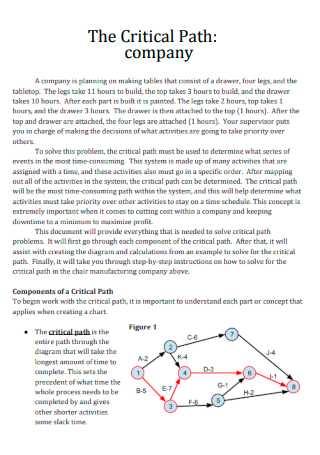
Company Critical Path
download now -
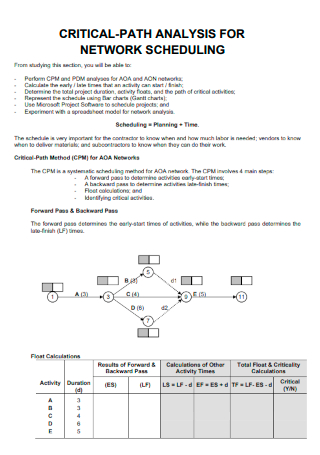
Critical Path Analysis for Network Scheduling
download now -
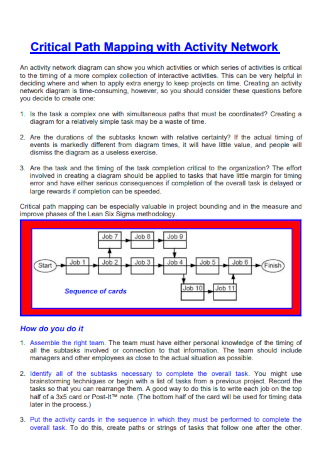
Critical Path Mapping with Activity Network
download now -
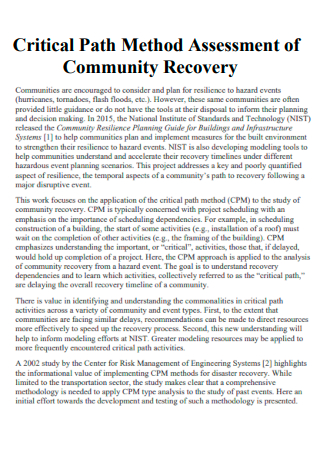
Critical Path Method Assessment of Community Recovery
download now -
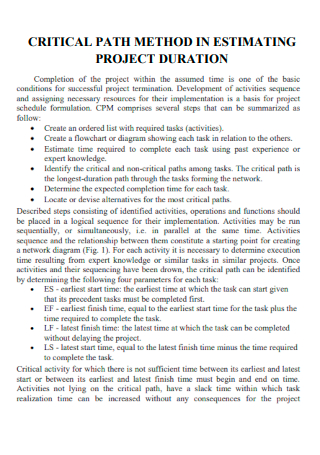
Critical Path Method in Estimating Project Duration
download now -
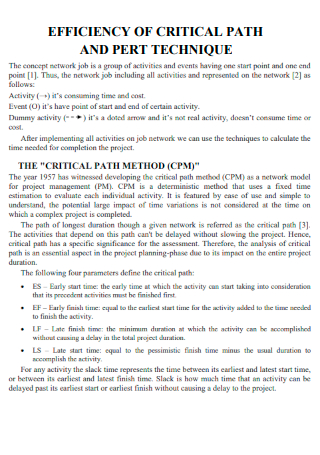
Efficiency of Critical Path and Pert Technique
download now -
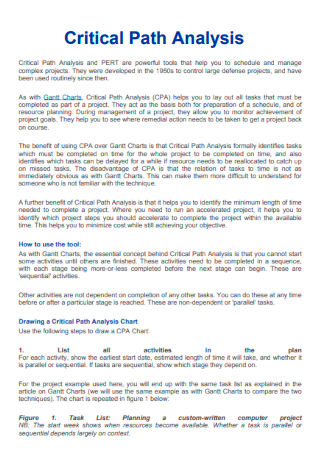
Critical Path Analysis
download now -
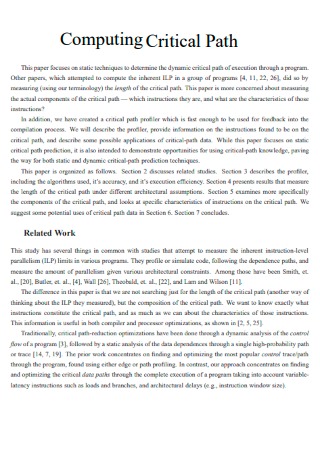
Computing Critical Path
download now
What Is a Critical Path?
A critical path is the longest sequence of tasks within a project plan that project teams must accomplish in a constrained time to ensure that the project is complete on or before the expected due date. Many projects contain a breakdown of activities and tasks that team members and employees perform to finish a project. The critical path refers to the series of actions that individuals follow in sequence while accounting for the different variables that will take the longest to complete a certain project. A critical path calculates the shortest project duration possible by lining up tasks and activities in the longest sequence of interdependent tasks that are necessary to complete a project. The critical path method or CPM is a process or technique that allows an organization to identify the tasks that are necessary for project completion and determines the scheduling flexibilities. CPM focuses on discovering the essential activities in the project timeline, identifying task dependencies, and calculating the duration to accomplish each task. CPM shows popularity when planning projects and organizing tasks and activities. It helps people to break down complex projects into individual and manageable tasks, gaining a better understanding of the flexibility of the project.
According to an article from Reuters dating March 23, 2022, there is a funding opportunity of over 2.9 billion US dollars coming from the Transportation Department for major infrastructure projects in the coming year. Many infrastructure projects utilize critical paths in their project plan to ensure that projects finish on time while utilizing the least amount of resources.
Associated Terms in Project Critical Path
Various variables are present when writing, developing or reading a critical path. There are elements or terms that people must be aware of when dealing with a critical path. The section below tackles the various concepts that an individual must understand when interacting and calculating the critical path.
How To Look for the Critical Path
For a project manager to determine the critical path for a particular project, they must determine and look for the duration of the critical and non-critical activities and actions. Finding the critical path of a project ensures that there will be no delays in accomplishing a project and that the team expects to fulfill it within a specified time. Looking for the critical path is a strenuous and time-consuming process that the project manager must fulfill to deliver the project successfully. The section below covers the necessary steps that a project manager must take to find the critical path of a project.
Step 1: Figure out and List All of the Necessary Activities for the Project
Before a project manager can start to identify or think about the critical path, they must figure out what tasks must be in the project. Use a work breakdown structure to identify and list all of the required tasks and activities in the project to produce the promised deliverables. The list in the work breakdown structure serves as the foundation for the rest of the critical path method. Take the time to speak with stakeholders to confirm the project details and guarantee that it aligns with the understanding of everyone involved. After acquiring all the vital information, list down the required activities and tasks in sequential order to complete the project.
Step 2: Identify the Task Dependencies
Regarding the work breakdown structure, determine and classify the activities that are dependent on one another. Doing so allows project managers to identify any work that is parallel to other tasks, allowing resources and team members to work simultaneously or continuously. The list of the dependent tasks is known as an activity sequence, and this help to determine the critical path in the following steps.
Step 3: Develop a Network Diagram
The next step to determining the critical path of a project is to transform the work breakdown structure into a network diagram. The network diagram is essentially a flowchart that displays the chronological order of tasks or activities in the project. The project manager starts by creating a box for each task and using arrows to symbolize the connection of task dependencies. The project manager then adds other time-bound components to the network diagram until there is a standard format and project schedule of when to start performing tasks and activities.
Step 4: Estimate the Duration of Each Task
To calculate the critical path or the longest sequence of a specific project containing critical tasks, project managers must have an estimate of the duration of each activity in the sequence. To calculate the duration, project managers can try to make educated guesses based on their knowledge and experience, and estimate according to previous data and industry standards. Project managers can also use the forward pass and backward pass techniques. Forward pass focuses on calculating the early start and early finish dates by using previously stated starting dates. An early start is the highest early finish value from previous tasks in the path, while an early finish constitutes an early start and the duration of the task. Determining the early start and finish dates allows teams and organizations to allocate resources early. Meanwhile, the backward pass calculates the late start and finish date. Calculate the late start by subtracting the late finish by the path duration, whereas the late finish is the lowest late start value from immediate successors. Use the early start and end dates to calculate the float or schedule the flexibility of a task.
Step 5: Calculate the Critical Path of the Project
The project manager or the organization can manually calculate the critical path. However, more organizations save time in calculating the path by using a critical path algorithm. If the project manager opts to calculate manually, the first step is to write the start and end dates of every activity. Take note that the first activity has a start time of 0, and the end time is the project duration. The next start time of the activity is the end time of the previous task, and the end time is the start time plus its duration. The next step is to look at the last activity in the sequence to determine the sequence duration. Check all of the activities and the sequence with the longest duration is the critical path. After identifying the critical path for a project, the project manager can build the project schedule.
Step 6: Calculate the Float of the Project
The float, or slack, is the amount of flexibility for a particular task. It gives room for error, indicating how long activities can go for a delay without having a severe impact on subsequent tasks or the end date. Finding the float is essential to gauge the overall flexibility of the project. Float is a resource that project managers use to cover the project risks or unexpected events that appear. Remember, critical paths have zero floats, meaning the dates are set. Tasks that have a positive float do not belong on the critical path, and it means that these tasks or activities have room for delays without it affecting the completion date of a project. If the team or organization is short on time or resources, it can choose to skip some non-critical tasks and activities in the project. Similar to the critical path, project managers can calculate the float manually or through an algorithm. Use the calculations to get the free float and the total float of the project. Free float refers to the delay in activity duration without affecting the following task. The presence of free float only happens if two or more activities share a shared successor. It is where the team or organization sees a convergence in a network diagram. Total float, on the other hand, is the amount of time that an activity can suffer delays from the early start date without causing complications to the finish date or violating the schedule constraints. There are different benefits and advantages when project managers understand the concept of float. Knowing about float gives them the ability to keep projects running on time, allows them to prioritize the most crucial tasks or activities in the project, and choose the most efficient way to utilize resources properly.
FAQs
How do you find the correct critical path for a project?
To find the correct critical path in a project, remember the definition of the critical path. A critical path is the longest path or sequence that is present in a project timeline. It starts with the first column in the network diagram, going through prerequisites until the final column.
What is the purpose of finding the critical path in a project?
Using a critical path for a project provides an estimate of the project duration and ensures that any project delays are back on track. However, the most significant purpose the critical path plays in a project is to identify the most essential tasks and ensures the project does not fall behind schedule.
What is the difference between PERT (Project/Program Evaluation Review Technique) and CPM?
PERT is a project management technique that project managers apply to a project when there is uncertainty in the end time or duration of the project. At the same time, CPM consists of an algorithm to determine the specific start and end dates of the project.
Creating a critical path for a project ensures team members working on a project or program have a clear schedule to follow. The time constraints that the critical path provides the team with information about the most vital activities that they must accomplish or perform to complete the project. Constructing the critical path also prevents a project from being behind schedule. As such, project managers must take the time to solve and look for the critical path in every project that they handle. Writing and computing for the critical path look difficult at first, but with experience and tools, a project manager can easily prepare one for their project. Develop a critical path by downloading from the template available in the article, only from Sample.net.


